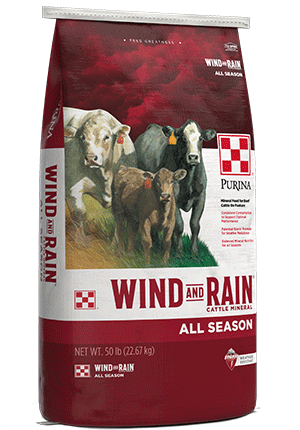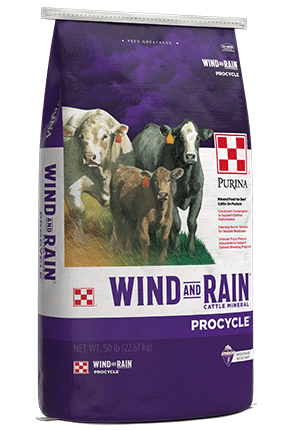
How Can You Maximize Your Cattle Mineral Investment?
Management : Cow & Calf
Nutrition : Minerals

Mineral can cost between $0.10-0.15 per cow per day, but it’s a worthy investment for the potential benefits in reproductive and overall cattle health.
Get an even better return on investment (ROI) on your mineral program with these three tips:
In addition, review the levels of key ingredients. For example, phosphorus is critical for both cow and calf performance. But, many minerals are short on phosphorus because it’s an expensive ingredient. Every 1% increase in phosphorus level will add about $1.50-2.00 per bag. However, the return on investment is well worth it.
By meeting the phosphorus needs of the cow, studies have shown an increase in percent calf crop weaned from 65% to 90%.1 On 100 cows, that could result in 25 more calves to sell. And, adequate phosphorus intake can result in an additional 50 pounds of weight per calf due to cows calving at the start of the season. At a sale price of $1.50 per pound, that’s an additional $75 of gross income per calf.
Proper intake also helps you realize the full value of other technologies such as fly control in mineral. Cows must consistently consume fly control mineral throughout summer and through the first frost to be effective. If cows don’t have consistent mineral intake, they get varied doses of fly control. Too low of a dose means they don’t get consistent fly control coverage. One study showed cows treated using fly control had an increase in calf weaning weights of 20 pounds.2 At a sale price of $1.50 per pound, that’s an additional $30 of gross income per head.3 At an estimated cost for Altosid® IGR of $9.00-9.50 per cow, fly control can result in a 3-1 return on dollar spent.4
Another way to maximize intake – and your mineral investment – is to avoid mineral waste from weather issues. Rain-soaked mineral can block up, causing cows not to eat it and mineral to go to waste. Purina® Wind and Rain® mineral protects against the weather and helps you avoid wasted product and money.
Does your cattle nutrition program stack up? Find out with a Proof Pays trial.
Get an even better return on investment (ROI) on your mineral program with these three tips:
1. Read the ingredient tag
Dig deeper to see what you’re really getting with mineral. The price per bag might look good, but the ingredients on the tag might be lacking, which can lead to cow health and reproductive issues. As you look at the ingredient sources utilized, they are not of equal bioavailability. Avoid using oxide forms of zinc, manganese and copper as these are poorly absorbed in the tissue and therefore are not available for reproduction and immune system function.In addition, review the levels of key ingredients. For example, phosphorus is critical for both cow and calf performance. But, many minerals are short on phosphorus because it’s an expensive ingredient. Every 1% increase in phosphorus level will add about $1.50-2.00 per bag. However, the return on investment is well worth it.
By meeting the phosphorus needs of the cow, studies have shown an increase in percent calf crop weaned from 65% to 90%.1 On 100 cows, that could result in 25 more calves to sell. And, adequate phosphorus intake can result in an additional 50 pounds of weight per calf due to cows calving at the start of the season. At a sale price of $1.50 per pound, that’s an additional $75 of gross income per calf.
2. Monitor mineral intake
Getting cows to eat mineral at the proper level is extremely important. If cows aren’t eating mineral at the recommended intake rate per cow per day, they could become mineral deficient. This is especially true for magnesium, which can have a bitter taste and cause cows not to eat mineral at the right level per head per day. Choose a highly palatable mineral like Purina® Wind and Rain® mineral to ensure consistent mineral intake.Proper intake also helps you realize the full value of other technologies such as fly control in mineral. Cows must consistently consume fly control mineral throughout summer and through the first frost to be effective. If cows don’t have consistent mineral intake, they get varied doses of fly control. Too low of a dose means they don’t get consistent fly control coverage. One study showed cows treated using fly control had an increase in calf weaning weights of 20 pounds.2 At a sale price of $1.50 per pound, that’s an additional $30 of gross income per head.3 At an estimated cost for Altosid® IGR of $9.00-9.50 per cow, fly control can result in a 3-1 return on dollar spent.4
Another way to maximize intake – and your mineral investment – is to avoid mineral waste from weather issues. Rain-soaked mineral can block up, causing cows not to eat it and mineral to go to waste. Purina® Wind and Rain® mineral protects against the weather and helps you avoid wasted product and money.
3. Consider long-term ROI
By meeting the mineral needs of your cattle upfront, you can proactively address herd health and reproductive issues, leading to optimal performance and reduced associated costs such as veterinary services and additional labor.Does your cattle nutrition program stack up? Find out with a Proof Pays trial.
1Black WH, Tash LH, Jones JM, Kleberg RJ. 1943. Effects of phosphorus supplements on cattle grazing on range deficient in this mineral. USDA.
2Campbell JB. 1976. Effect of horn fly control on cows as expressed by increased weaning weights of calves. University of Nebraska. Journal of Economic Entomology.
3Due to influences outside of Purina Animal Nutrition LLC’s control, results to be obtained, such as financial performance, animal condition, health or performance cannot be predicted or guaranteed by Purina Animal Nutrition LLC.
4Altosid is a registered trademark of Wellmark International.
2Campbell JB. 1976. Effect of horn fly control on cows as expressed by increased weaning weights of calves. University of Nebraska. Journal of Economic Entomology.
3Due to influences outside of Purina Animal Nutrition LLC’s control, results to be obtained, such as financial performance, animal condition, health or performance cannot be predicted or guaranteed by Purina Animal Nutrition LLC.
4Altosid is a registered trademark of Wellmark International.




